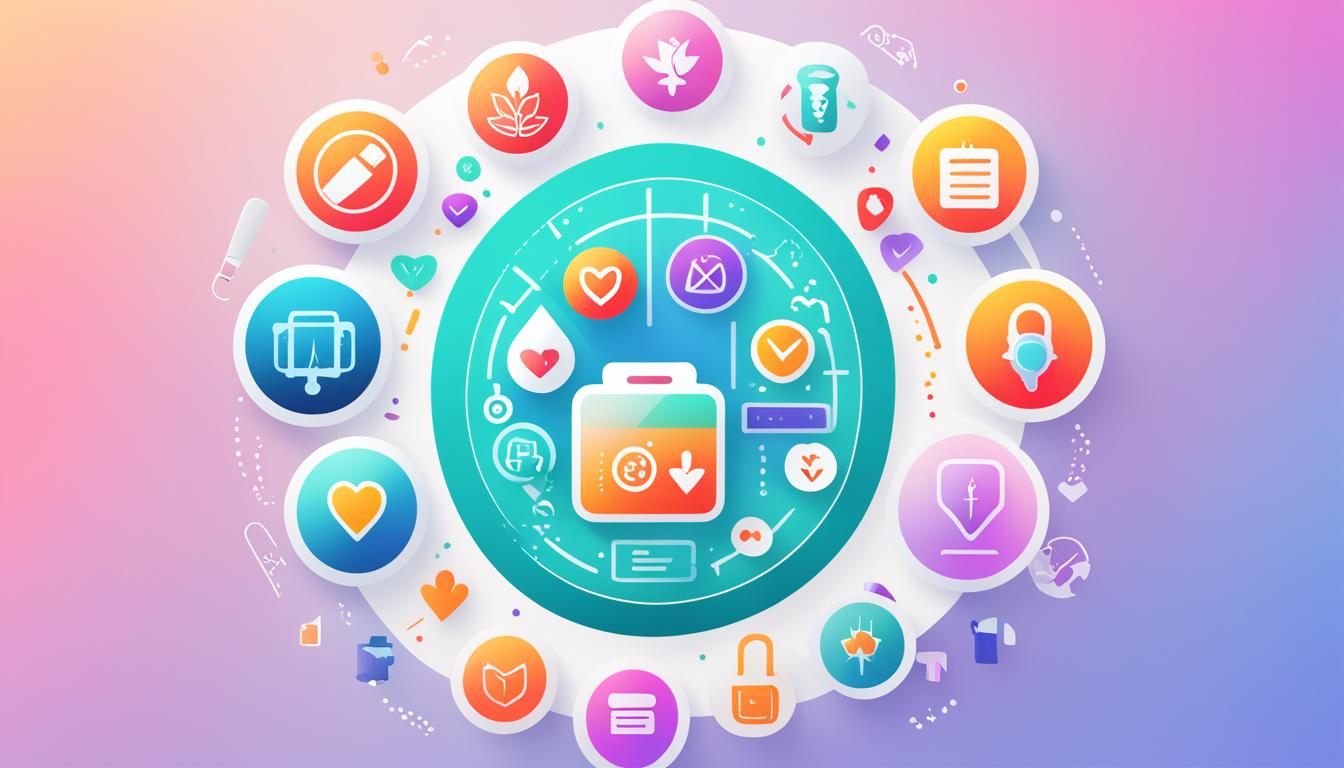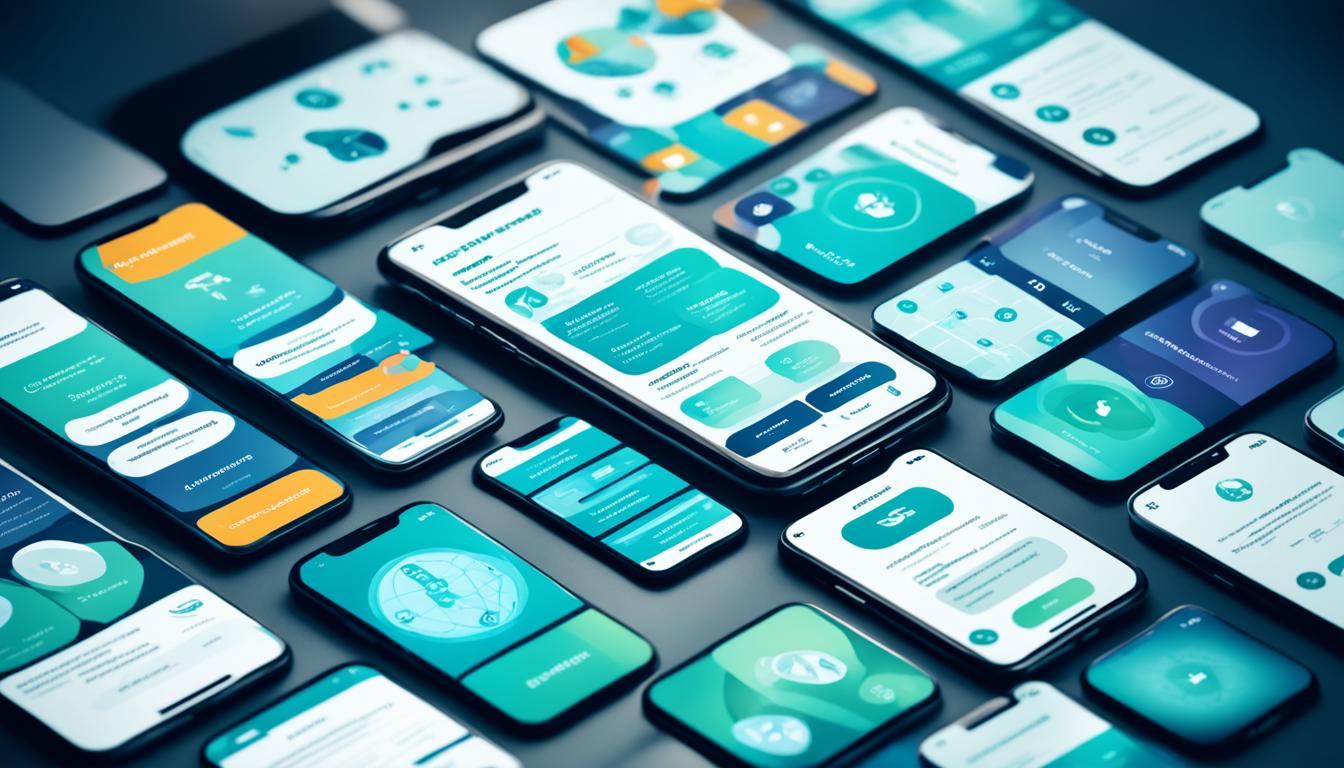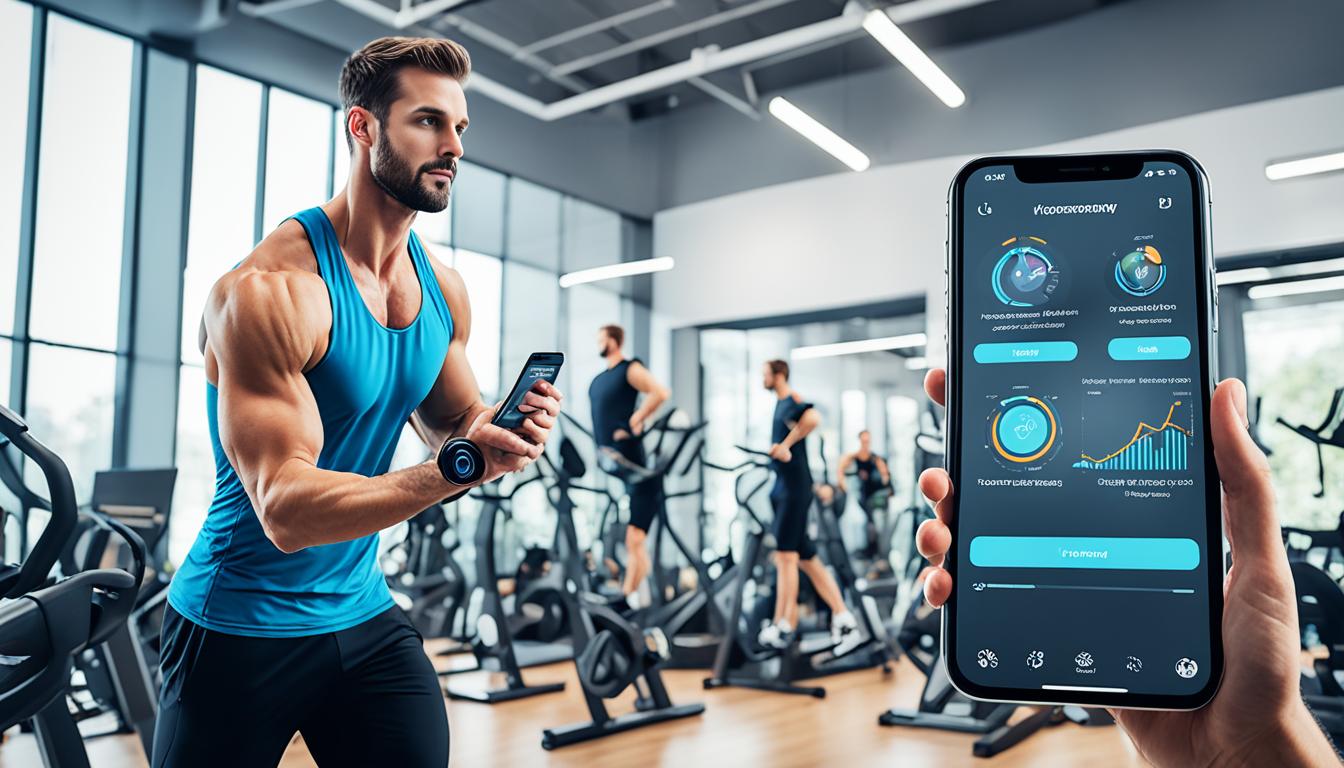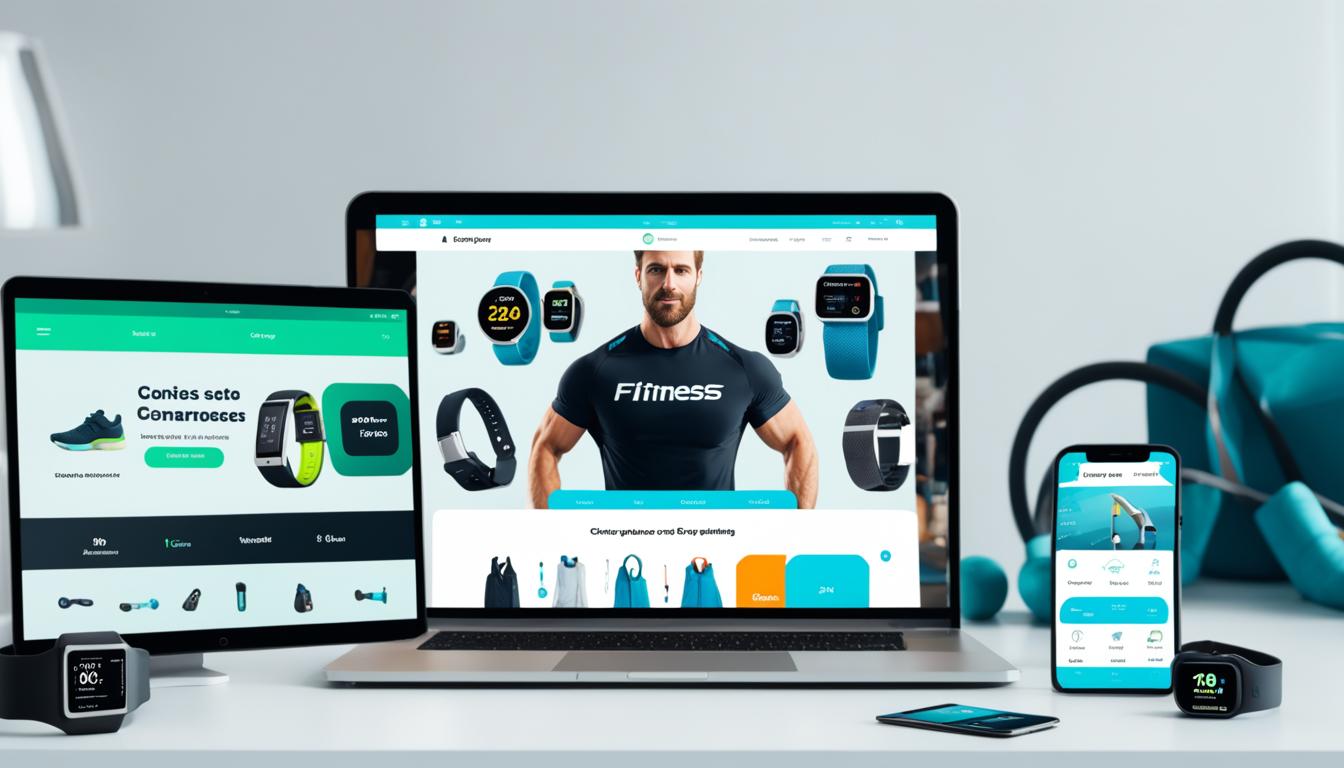Welcome to our article series on the vanguard of virtual fitness. In this series, we explore how mobile apps are revolutionizing wellness routines and transforming the healthcare landscape. The integration of technology in healthcare has opened up new possibilities for individuals to take control of their health and well-being like never before. Mobile app development and design are at the forefront of this digital transformation, empowering users with personalized solutions, streamlined communication, and improved health outcomes.
With the global healthcare app market projected to reach $105.09 billion by 2030, it is clear that mobile apps are not just a passing trend but an integral part of the future of healthcare. As an app development company, we are excited to delve into the latest trends and advancements in mobile app development that are shaping virtual fitness and wellness routines.
Join us in exploring the surge in mobile health app development, the significant rise of the global healthcare app market, and the intersection of technology and personal health. We will also dive into the spectrum of healthcare apps, from those catering to patients to those designed for healthcare providers and medical administration staff.
Furthermore, we will shine a light on personalized fitness regimens via health apps and the role of artificial intelligence (AI) in crafting custom workouts. We will also discuss how fitness apps integrate habit tracking and social networking features to promote healthier lifestyles and cater to the unique needs of women’s health and fitness.
In addition, we will highlight technology-enabled solutions for healthcare providers and examine the exciting integration of apps and wearables in the fitness industry. By leveraging the data-driven personal training strategies and the symbiotic relationship between apps and wearables, we can unlock the potential for a holistic approach to wellness.
Throughout this series, we will delve into the ever-evolving landscape of mobile app development and explore how it is redefining user experience in fitness. We will also navigate the compliance and security aspects of health app creation and forecast future trends in virtual fitness technologies.
Lastly, we will introduce you to Ztec100 Tech Fitness, a leading fitness technology company that capitalizes on tech innovation to revolutionize the fitness industry. With personalized workouts, real-time tracking, and AI-powered coaching, Ztec100 Tech Fitness offers comprehensive tech fitness solutions.
We look forward to embarking on this journey with you as we uncover the forefront of virtual fitness and explore the incredible potential of mobile apps in wellness routines.
Key Takeaways:
- Mobile apps have revolutionized the healthcare industry, shaping wellness routines and transforming the way individuals approach their health and well-being.
- The integration of technology in healthcare has led to the surge in mobile health app development and a significant rise in the global healthcare app market.
- Healthcare apps cater to the needs of patients, healthcare providers, and medical administration staff, enhancing patient care and streamlining workflows.
- Personalized fitness apps leverage AI, habit tracking, and social networking features to provide tailored solutions and support for individual needs.
- Technology-enabled solutions and the integration of apps and wearables are revolutionizing the delivery of healthcare services and personal training.
Embracing the Digital Transformation in Healthcare
The healthcare industry is in the midst of a monumental shift as it embraces the digital transformation. A key driver of this transformation is the surge in mobile health app development, which has revolutionized how healthcare providers and patients approach healthcare. With the widespread adoption of smartphones and advancements in technology, mobile health apps have become invaluable tools for monitoring, diagnosis, and treatment.
Mobile health apps intersect healthcare technology and personal health, offering innovative solutions that enhance wellness routines. These apps empower both healthcare providers and patients by providing convenient and accessible tools for managing health. From fitness tracking to medication reminders, symptom monitoring to telemedicine consultations, mobile health apps are redefining the way healthcare is delivered and experienced.
The Surge in Mobile Health App Development
The rise of mobile health app development is driving the digital transformation in healthcare. As the demand for convenient healthcare solutions grows, developers are creating apps that cater to a wide range of needs. Patients can now easily access information, track their health metrics, and communicate with healthcare providers from the palm of their hand.
From fitness and nutrition apps to mental health and chronic disease management tools, there is a mobile health app for almost every aspect of healthcare. These apps enable individuals to take a proactive role in managing their health, improving patient engagement and ultimately leading to better health outcomes.
The Significant Rise of the Global Healthcare App Market
The global healthcare app market is experiencing significant growth, reflecting the increasing demand for mobile health apps. According to industry projections, this market is set to reach $105.09 billion by 2030. This growth can be attributed to several factors, including the growing adoption of smartphones, advancements in healthcare technology, and evolving consumer expectations.
As the healthcare app market expands, so does the range of available apps. From large healthcare organizations to startups, companies are investing in the development of mobile health apps to capitalize on this growing market. These apps offer opportunities for revenue generation, improved patient care, and enhanced healthcare delivery.
The Intersection of Technology and Personal Health
The digital transformation in healthcare is built on the intersection of technology and personal health. Mobile health apps serve as a bridge between the two, leveraging technology to provide personalized and targeted solutions for individuals’ health needs. By leveraging features such as artificial intelligence, machine learning, and data analytics, these apps can offer tailored recommendations, personalized workout plans, and customized treatment options.
Furthermore, mobile health apps empower patients by giving them greater control over their health. Individuals can access their health records, manage appointments, and make informed decisions about their care. Healthcare providers also benefit from these apps, as they can remotely monitor patients, streamline communication, and deliver more personalized care.
As the digital transformation in healthcare continues to advance, mobile health apps will play an increasingly vital role in reshaping the healthcare landscape. By leveraging technology and prioritizing personal health, these apps have the potential to vastly improve patient outcomes and create a more connected and efficient healthcare ecosystem.
Understanding the Spectrum of Healthcare Apps
Healthcare apps encompass a diverse array of functionalities, catering to the needs of patients, healthcare providers, and medical administration staff. These apps revolutionize patient care, provider workflows, and administrative processes, creating a more interconnected, efficient, and patient-centric healthcare ecosystem. Understanding the different types of healthcare apps is crucial in exploring the comprehensive solutions they offer to enhance the healthcare experience.
Healthcare apps can be categorized into three main types: patient apps, provider apps, and medical administration apps.
- Patient apps empower individuals to take control of their health and well-being. These apps offer features such as symptom trackers, medication reminders, personalized health advice, and access to telehealth services. Patient apps promote proactive healthcare management, encourage behavior change, and facilitate virtual consultations with healthcare professionals.
- Provider apps streamline healthcare delivery and improve communication between healthcare providers. These apps enhance clinical workflows, support remote patient monitoring, facilitate secure messaging, and provide access to electronic health records (EHRs). Provider apps enable healthcare teams to collaborate effectively, enhance patient care coordination, and optimize the efficiency of medical practices.
- Medical administration apps simplify administrative processes in healthcare settings. These apps assist with tasks such as appointment scheduling, insurance claims processing, billing, and inventory management. Medical administration apps automate manual processes, reduce administrative burden, and ensure smooth operations in medical facilities.
By leveraging these types of healthcare apps, individuals can actively participate in their own care, healthcare providers can deliver more efficient and personalized services, and medical administration staff can streamline administrative tasks.
Healthcare apps revolutionize the way patients, providers, and medical administrators interact and collaborate, creating a more seamless and patient-centric healthcare experience. Whether it’s empowering patients to monitor their health or streamlining administrative processes, these apps play a crucial role in enhancing the healthcare ecosystem.
To further illustrate the spectrum of healthcare apps, below is a table summarizing the key features and benefits of patient apps, provider apps, and medical administration apps.
| Types of Healthcare Apps | Key Features | Benefits |
|---|---|---|
| Patient Apps | Symptom tracking, medication reminders, telehealth access | Improved self-care, proactive health management, virtual consultations |
| Provider Apps | Remote patient monitoring, secure messaging, EHR access | Enhanced clinical workflows, improved care coordination, efficient communication |
| Medical Administration Apps | Appointment scheduling, claims processing, inventory management | Streamlined administrative processes, reduced manual tasks, increased operational efficiency |

Understanding the different types of healthcare apps allows individuals and healthcare organizations to harness their full potential in improving patient outcomes, optimizing healthcare delivery, and enhancing administrative efficiency. Embracing these technological advancements is vital for the future of healthcare.
Personalized Fitness Regimens via Health Apps for Patients
Health apps designed for patients offer personalized fitness regimens tailored to individual needs. These apps utilize advanced technology and innovative features to enhance the fitness experience for users, providing them with customized solutions to achieve their health goals.
The Role of AI in Crafting Custom Workouts
Artificial Intelligence (AI) plays a significant role in crafting custom workouts within health apps. By analyzing data such as user preferences, fitness levels, and specific health conditions, AI algorithms can generate personalized exercise routines that optimize results and minimize the risk of injury. AI-powered fitness apps take into account various factors to create workouts that are tailored to the user’s abilities, ensuring a safe and effective fitness journey.
Integrating Habit Tracking and Social Networking
Habit tracking is a crucial component of many health apps, allowing users to monitor their progress, set goals, and stay motivated. These apps provide features that enable users to track their daily activities, such as steps taken, calories burned, and even sleep patterns. By integrating habit tracking into the app, users can easily monitor their fitness habits and make adjustments to improve their overall well-being.
Additionally, health apps often incorporate social networking features, creating a sense of community and support among users. By connecting with friends, family, or like-minded individuals, users can share their fitness achievements, participate in challenges, and receive encouragement, fostering a positive and interactive fitness environment.
Women’s Health and Fitness: Tailored Solutions
Women’s health and fitness apps cater to the unique needs and experiences of female users. These apps offer specific solutions and support related to reproductive health, menstrual cycles, pregnancy, and postpartum fitness. By providing tailored guidance and resources, women’s health and fitness apps empower users to take control of their wellness journey in a way that aligns with their individual needs and preferences.
Technology-Enabled Solutions for Healthcare Providers
Technology has revolutionized the healthcare industry, empowering healthcare providers with a wide range of solutions to enhance patient care and improve efficiency. Digital tools, mobile apps, and software have become essential components in optimizing workflows, facilitating remote patient monitoring, improving diagnostics, and enhancing communication. Healthcare providers are embracing these technology-enabled solutions to deliver more efficient and effective healthcare services.

These technology-enabled solutions offer numerous benefits for healthcare providers and their patients. By leveraging digital tools and healthcare provider apps, healthcare professionals can streamline administrative tasks, automate processes, and access critical information in real-time. This allows for more accurate and timely decision-making, ultimately leading to improved patient outcomes.
The integration of digital tools and mobile apps empowers healthcare providers to optimize workflows, facilitate remote patient monitoring, improve diagnostics, and enhance communication.
For example, healthcare provider apps provide features such as secure messaging platforms that enable seamless communication between healthcare professionals and patients. This promotes enhanced care coordination, improved patient engagement, and efficient delivery of healthcare services.
Furthermore, technology-enabled solutions enable remote patient monitoring, allowing healthcare providers to monitor patients’ health conditions in real-time. This not only improves patient access to care but also reduces the need for in-person visits, particularly for patients with chronic conditions.
Overall, technology-enabled healthcare solutions, including digital tools and healthcare provider apps, have the potential to revolutionize the way healthcare is delivered. These solutions enhance efficiency, improve patient outcomes, and pave the way for a more patient-centric healthcare system.
Benefits of Technology-Enabled Solutions for Healthcare Providers
| Benefits | Description |
|---|---|
| Streamlined Workflows | Optimize administrative tasks and automate processes |
| Real-time Information Access | Enable healthcare professionals to access critical information instantly |
| Improved Communication | Facilitate secure messaging platforms for seamless communication between healthcare professionals and patients |
| Remote Patient Monitoring | Monitor patients’ health conditions in real-time and reduce the need for in-person visits |
| Enhanced Care Coordination | Promote improved care coordination among healthcare providers |
| Improved Patient Engagement | Empower patients to actively participate in their healthcare journey |
The Revolutionary Integration of Apps and Wearables
The integration of apps and wearables in the fitness industry has revolutionized personal training and wellness. By combining the capabilities of fitness apps and health tracking wearables, individuals can now experience a holistic approach to wellness like never before.
TrueCoach and OURA: A Case Study in Symbiosis
TrueCoach and OURA serve as a compelling case study in the symbiotic relationship between apps and wearables. TrueCoach, a leading fitness app, seamlessly integrates with OURA, a state-of-the-art health tracking wearable, to provide users with a comprehensive and tailored fitness experience.
Through this integration, TrueCoach leverages the data gathered by the OURA ring, such as sleep patterns, heart rate, and activity levels, to create personalized fitness plans. Users can track their progress, receive real-time insights, and adjust their workouts based on the data collected by their wearable device. This symbiosis between TrueCoach and OURA enhances the effectiveness and precision of personal training, empowering individuals to achieve their fitness goals.
Data-Driven Personal Training Strategies
One of the key advantages of integrating apps and wearables is the ability to utilize data-driven personal training strategies. Wearables capture a wealth of information about an individual’s health and fitness, providing valuable insights that can be used to optimize training programs.
With the integration of fitness apps and wearables, personal trainers and fitness enthusiasts can develop personalized workout plans based on real-time data. This data includes metrics like heart rate, sleep quality, calorie expenditure, and exercise intensity. By leveraging this information, trainers can tailor workouts to the individual’s needs, adjust training intensities, and monitor progress more accurately.
Data-driven personal training strategies offer a more precise and targeted approach to fitness, ensuring that individuals are maximizing their potential and making progress towards their goals.
Crafting a Holistic Approach to Wellness
The integration of apps and wearables allows for a holistic approach to wellness by considering various aspects of an individual’s health. These integrated solutions encompass not only physical fitness but also other important dimensions of well-being, such as sleep, stress levels, and overall lifestyle.
By gathering data from wearables and analyzing it through fitness apps, individuals can gain a deeper understanding of their overall health and make informed decisions to achieve a better balance in their lives. This holistic approach acknowledges that wellness is not solely about physical fitness but also encompasses mental and emotional well-being.
The integration of apps and wearables has revolutionized personal training and wellness, offering a comprehensive and tailored fitness experience. By combining the capabilities of fitness apps and health tracking wearables, individuals can benefit from data-driven personal training strategies and craft a holistic approach to wellness.
Mobile App Development and Trends
How Mobile Apps Are Redefining User Experience in Fitness
The world of fitness has been revolutionized by mobile app development, with apps redefining the user experience and driving innovation. These apps have transformed the way users engage with fitness, offering seamless integration, personalized features, and immersive experiences. Whether it’s tracking progress, accessing workout routines, or connecting with a fitness community, mobile apps have become essential tools for individuals looking to improve their health and well-being.
Mobile apps provide users with convenient access to a wide range of fitness resources, right at their fingertips. From personalized workout plans tailored to an individual’s goals and preferences to real-time tracking of progress and performance, these apps enhance the overall fitness journey. Users can easily track their steps, heart rate, calories burned, and more, allowing them to stay motivated and accountable on their fitness goals.
Additionally, mobile apps have transformed the way users interact with fitness professionals. Through these apps, users can access virtual coaching and guidance, receiving expert advice and personalized feedback. Whether it’s through video tutorials, live classes, or one-on-one consultations, mobile apps have opened up new avenues for users to receive professional support and assistance on their fitness journey.
One example of how mobile apps are redefining the user experience in fitness is with the integration of augmented reality (AR) and virtual reality (VR) technologies. These technologies allow users to immerse themselves in virtual fitness environments, providing a more engaging and interactive workout experience. Users can explore virtual landscapes, participate in virtual fitness classes, and even compete with others in virtual challenges, all from the comfort of their own homes.
Moreover, mobile app development in fitness has also led to the integration of gamification elements, making workouts more fun and enjoyable. Users can compete with friends and earn rewards for achieving fitness milestones, creating a sense of friendly competition and motivation. This integration of gamification has proven to be an effective strategy for increasing user engagement and adherence to fitness routines.
Navigating Compliance and Security in Health App Creation
When it comes to developing health apps, compliance and security are of utmost importance. The privacy and safety of users’ data must be safeguarded to ensure their trust in the app. Developers must adhere to legal and regulatory standards, such as the Health Insurance Portability and Accountability Act (HIPAA) in the United States, which governs the privacy and security of personal health information.
Compliance involves ensuring that health apps meet all legal requirements and industry standards for data protection and privacy. This includes implementing secure data storage and transmission practices, obtaining necessary consents from users, and providing transparent information about data collection and usage. By maintaining compliance, developers establish trust with users and demonstrate their commitment to protecting their sensitive health information.
Security measures must be in place to prevent unauthorized access, data breaches, and other cybersecurity threats. This includes using encryption for data transmission, implementing robust authentication and access controls, and regularly conducting security audits and vulnerability assessments. By prioritizing security, developers can mitigate risks and safeguard users’ data and privacy.
Forecasting Future Trends in Virtual Fitness Technologies
As technology continues to advance, virtual fitness is poised to witness significant growth and evolution. Future trends in virtual fitness technologies emphasize the integration of innovative features and immersive experiences to enhance user engagement and deliver personalized fitness solutions.
One emerging trend is the incorporation of artificial intelligence (AI) and machine learning algorithms into fitness apps. These technologies can analyze user data, such as workout performance and biometrics, to provide personalized recommendations and optimize training plans. AI-powered virtual coaches can offer real-time feedback, track progress, and adapt workouts based on individual needs and goals.
Virtual reality (VR) and augmented reality (AR) technologies are also likely to play a prominent role in the future of virtual fitness. These technologies create immersive workout environments, allowing users to escape their physical surroundings and engage in virtual fitness experiences. From exploring far-off landscapes to participating in interactive fitness games, users can elevate their fitness routines and make them more enjoyable.
Integration with wearable devices is another trend that will continue to shape virtual fitness technologies. Wearables, such as smartwatches and fitness trackers, provide real-time tracking of biometrics and enable seamless synchronization with fitness apps. This integration allows users to monitor their progress, receive personalized recommendations, and track health metrics more effectively.
The future of virtual fitness technologies is also likely to focus on enhanced interconnectivity and social engagement. Users will have the ability to connect, compete, and collaborate with others in virtual fitness communities, fostering accountability, motivation, and a sense of camaraderie.

By staying informed about the latest trends and leveraging cutting-edge technologies, developers can drive innovation in the virtual fitness space. The possibilities for enhancing user experiences and delivering personalized, immersive fitness solutions are limitless.
Capitalizing on Tech Innovation with Ztec100 Tech Fitness
Ztec100 Tech Fitness is a leading fitness technology company that is at the forefront of capitalizing on tech innovation to revolutionize the fitness industry. With our cutting-edge solutions, we are transforming the way individuals approach their health and well-being.
At Ztec100 Tech Fitness, we understand the importance of personalized fitness regimens. Our platform offers users personalized workouts that are tailored to their specific needs and goals. Whether you’re looking to build strength, improve endurance, or lose weight, our tech fitness solutions provide comprehensive guidance and support throughout your fitness journey.
Real-time tracking is another key feature of our platform. We believe that continuous monitoring is essential for progress and motivation. With our advanced tracking capabilities, you can seamlessly track your workouts, monitor your performance, and stay accountable to your fitness goals.
One of the highlights of Ztec100 Tech Fitness is our AI-powered coaching. We leverage artificial intelligence to provide you with personalized recommendations and guidance based on your unique data. Our AI algorithms analyze your workout history, performance metrics, and other relevant factors to offer insights and optimize your training. This intelligent coaching ensures that you are constantly challenged and progressing towards your fitness objectives.
“Ztec100 Tech Fitness is revolutionizing the fitness industry by merging cutting-edge technology with health and wellness. With personalized workouts, real-time tracking, and AI-powered coaching, we provide users with a holistic approach to achieving their fitness goals.”
Our commitment to merging technology with fitness extends to all aspects of our platform. From user-friendly interfaces to seamless data integrations with wearable devices, we strive to provide a seamless and immersive fitness experience. Our goal is to empower individuals with the tools and knowledge they need to transform their lives through fitness.
At Ztec100 Tech Fitness, we believe that fitness is not just about physical health but also mental and emotional well-being. Our comprehensive approach to health and well-being takes into account all aspects of your life, helping you craft a balanced and sustainable fitness routine.
Join us at Ztec100 Tech Fitness and discover the power of tech innovation in revolutionizing your fitness journey. Together, we can achieve greatness and unlock your full potential.
Maximizing User Engagement Through Interface and Usability
Assessing the User-Friendliness of Fitness Apps
When it comes to fitness apps, user engagement is crucial for long-term success. A user-friendly interface is a key factor in keeping users motivated and committed to their fitness goals. Fitness apps should prioritize intuitive design and easy navigation, ensuring that users can easily find and utilize the features they need. By providing a seamless and enjoyable user experience, fitness apps can enhance user engagement and encourage consistent usage.
One way to assess the user-friendliness of fitness apps is through user testing and feedback. Conducting usability tests with a diverse group of users can provide valuable insights into the app’s strengths and areas for improvement. Gathering feedback from users about their experience with the app’s interface, features, and overall usability can help identify any pain points or areas of confusion.
Connectivity and Integrations: Enhancing the Fitness Journey
Connectivity plays a vital role in enhancing the fitness journey. Fitness apps that seamlessly integrate with other devices, platforms, and wearables offer a more holistic and comprehensive experience for users. These integrations allow users to track their progress, monitor their workouts, and seamlessly synchronize data across multiple devices.
For example, fitness apps can connect with smartwatches and fitness trackers to provide real-time tracking of steps, heart rate, and other key metrics. By integrating with nutrition apps, users can easily track their calorie intake and meals, creating a more holistic approach to health and wellness. Connectivity and integrations not only enhance the overall fitness experience but also provide users with a more accurate and complete view of their progress.
Guiding New Users: Setting Up for Success with Ztec100
For new users, setting up a fitness app can sometimes be overwhelming. To ensure their success and optimize their experience, Ztec100 Tech Fitness provides a guided setup process. This step-by-step onboarding process helps new users get acquainted with the app’s features and functionalities, ensuring that they can navigate the app with ease.
Ztec100 Tech Fitness also offers informative tutorials, instructional videos, and in-app support to assist new users in getting started. Clear and concise instructions help users set up their profiles, input their fitness goals, and customize their workout routines. By providing guidance and support from the beginning, Ztec100 Tech Fitness sets up users for success on their fitness journey.
Proactive Support and Troubleshooting in Mobile Fitness Platforms
At Ztec100 Tech Fitness, we understand the importance of providing proactive support and troubleshooting to ensure a seamless experience for our users. We believe that robust customer support is essential in addressing user inquiries and resolving issues promptly to create a positive and engaging fitness app environment.
Our support team is dedicated to assisting users with any questions or concerns they may have. Whether it’s troubleshooting fitness app issues, providing guidance on app functionality, or addressing technical difficulties, we are committed to delivering timely and effective solutions.
We also understand that users may encounter common issues when using fitness apps. To empower our users with the knowledge to resolve these issues independently, we provide comprehensive troubleshooting guides and resources. These guides cover a wide range of topics, from app navigation to syncing wearable devices, ensuring that users have the information they need to overcome any challenges that may arise.
Our proactive support extends beyond troubleshooting. We continuously collect user feedback and incorporate it into our app development process, addressing user concerns and improving app functionality. This collaborative approach allows us to create a user-centric experience and ensures that our fitness app meets the evolving needs of our community.

At Ztec100 Tech Fitness, we believe that proactive support is the key to creating a seamless and satisfying mobile fitness platform. By offering robust customer support, comprehensive troubleshooting resources, and incorporating user feedback, we strive to provide our users with the best possible fitness app experience.
Conclusion
The virtual fitness revolution, powered by mobile apps, is transforming wellness routines and revolutionizing the way individuals approach their health and well-being. By integrating technology into healthcare and fitness, we are able to provide personalized solutions, improve patient care, and enhance user experiences. This shift towards virtual fitness has opened up exciting possibilities in mobile app development, wearable integration, and the advancement of virtual fitness technologies.
In the healthcare industry, mobile apps have become vital tools in promoting better patient engagement, streamlining communication, and ultimately improving health outcomes. The global healthcare app market is projected to reach $105.09 billion by 2030, highlighting the immense potential and growing significance of mobile applications in reshaping the healthcare landscape.
With the rise of mobile health app development, we are witnessing a significant change in how healthcare is delivered and how individuals take charge of their health. These apps provide access to personalized fitness regimens, leverage AI to craft custom workouts, and integrate habit tracking and social networking features to promote healthier lifestyles. Additionally, women’s health and fitness apps are catering to the unique needs and experiences of female users.
As the industry continues to evolve, the potential for innovation and positive change in the wellness landscape is boundless. Advancements in mobile app development, the integration of wearable devices, and the adoption of virtual fitness technologies will further enhance the way we approach and maintain our well-being. With these exciting possibilities, we are poised to shape a future in which technology plays a pivotal role in promoting overall health and empowering individuals to achieve their wellness goals.
